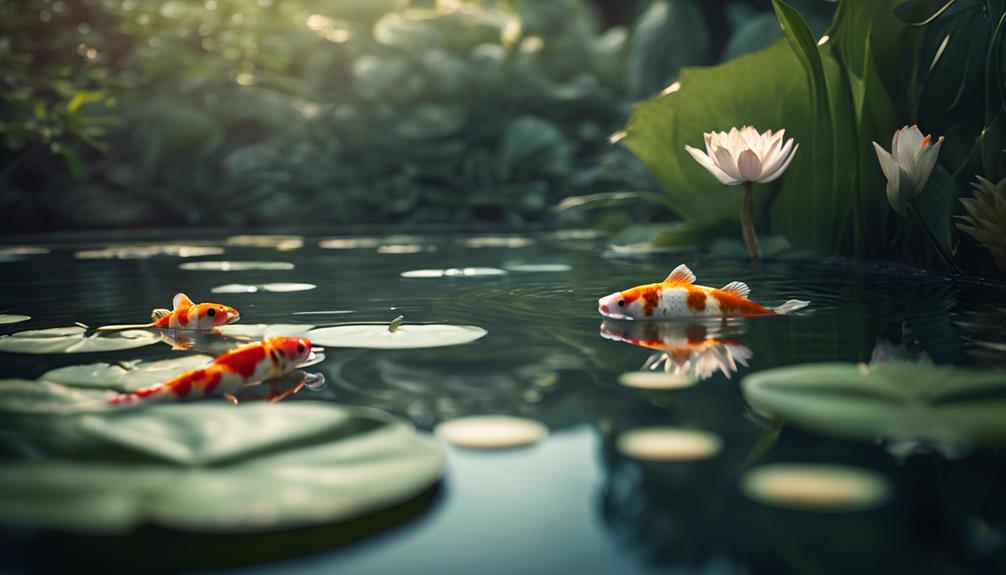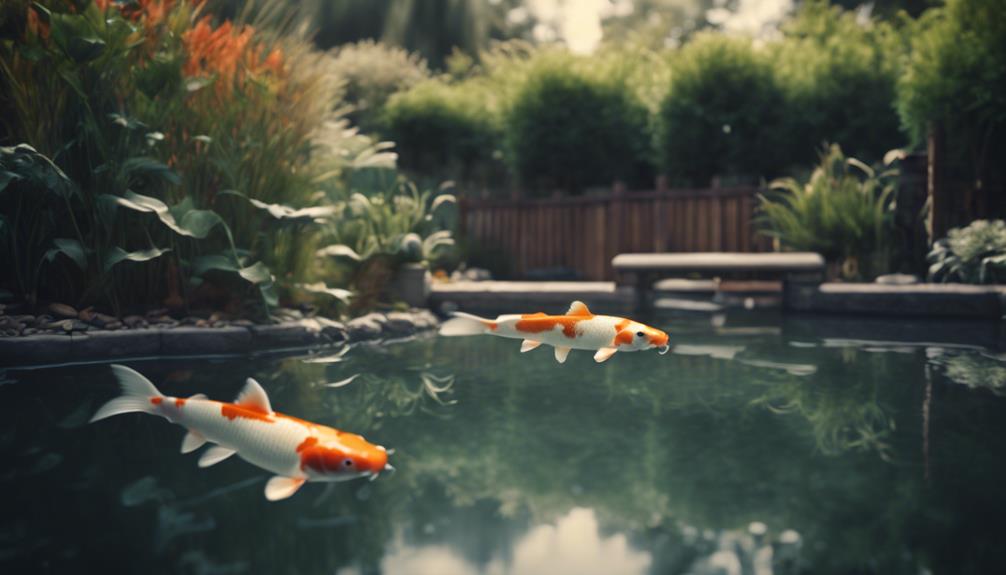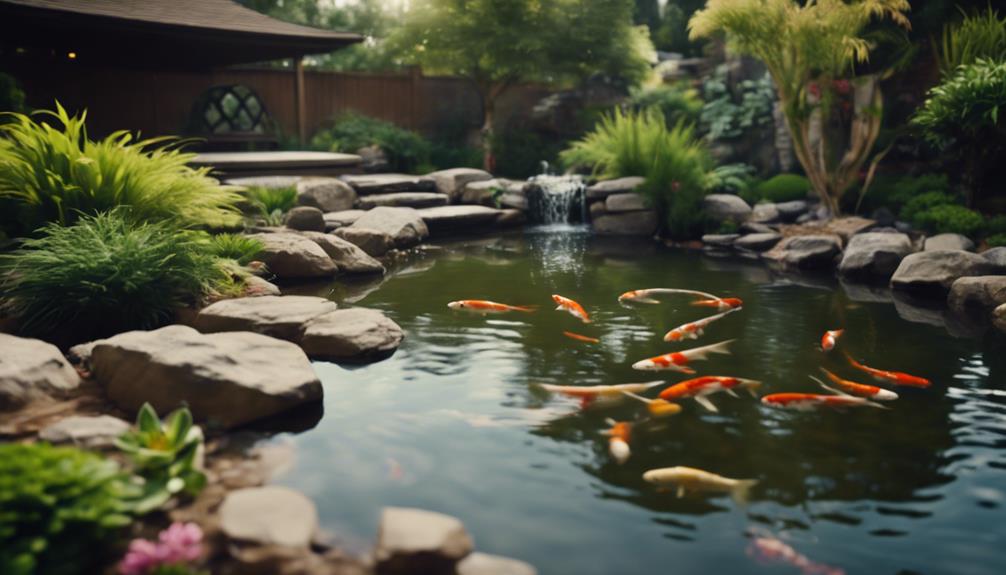You'll need a dedicated breeding pond with a reliable filtration system to maintain prime water temperatures and quality, simulating natural conditions that trigger koi breeding. Adequate filtration and suitable spawning media, like artificial plants or a spawning mat, are also vital. Fine-tune the environment by adjusting water temperatures and quality to encourage breeding behavior. A safe and healthy environment is essential, as koi can be stressed during the complex courtship ritual. By creating an ideal breeding environment, you'll increase your chances of success – and that's just the beginning of your koi breeding journey.
Table of Contents
Key Takeaways
- A dedicated breeding pond with a reliable filtration system maintains prime water temperatures and quality.
- Suitable spawning media, such as artificial plants or a spawning mat, encourages koi to breed naturally.
- Fine-tuning the breeding environment by adjusting water temperatures and quality simulates natural conditions that trigger koi breeding.
- A safe and healthy environment is critical, as koi breeding can be stressful for the fish, especially during the complex courtship ritual.
- Providing sufficient space for koi to breed and grow ensures a healthy and sustainable environment.
Preparing the Breeding Environment
To successfully breed koi, you must first prepare a suitable breeding environment that meets the specific needs of your fish, as inadequate water quality and poor tank conditions can profoundly impact the health and fertility of your breeding stock.
A dedicated breeding pond with a reliable filtration system is essential for maintaining prime water temperatures and water quality. Adequate filtration will guarantee that your koi are healthy and stress-free, which is critical for successful breeding.
You'll also need to provide suitable spawning media, such as artificial plants or a spawning mat, to encourage your koi to breed naturally.
As the breeding season approaches, you'll want to fine-tune your breeding environment by adjusting water temperatures and water quality to simulate the natural conditions that trigger koi breeding.
When you've created an ideal environment, your koi will begin to exhibit breeding behavior, and you'll be well on your way to successfully breeding koi. By paying close attention to these details, you'll set yourself up for success and create a thriving breeding environment that fosters healthy, vibrant koi.
Understanding Koi Mating and Breeding
As you prepare to breed your koi, it is crucial to comprehend the intricacies of their mating and breeding behavior, which is pivotal for successfully propagating these beautiful fish.
Koi fish breeding typically occurs in late spring or early summer, between May and June, when water temperatures reach 65°F to 70°F.
During this natural spawning process, male koi chase females, nudging their sides with their mouth and fins to encourage egg-laying. The females then release eggs, which are fertilized by the males.
You may notice cloudy or foamy water with a distinct odor, indicating that spawning is taking place.
The complex courtship ritual can be stressful for the fish, so it is crucial to provide a safe and healthy environment.
After spawning, the parents will consume some eggs, a natural form of culling.
By understanding koi mating and breeding behavior, you'll be better equipped to breed koi and create a thriving water garden.
Caring for Koi Eggs and Fry

You'll need to provide a safe and nutritious environment for the koi eggs and fry to thrive, since they're extremely vulnerable to predators, disease, and water quality issues.
After the female koi lays her eggs, you'll want to separate them from the breeding tank to prevent diseases and increase your chances of successful hatching.
Fertilized eggs will typically hatch within 3-5 days, depending on water temperature and quality.
Once the fry hatch, they'll absorb their yolk sacs and start swimming around. Make sure to provide a cycled tank with stable ammonia levels and plenty of gallons of water to support the baby koi's growth.
Regular water changes and monitoring of water parameters will help prevent diseases and certify the fry's survival.
Feeding and Nurturing Young Koi
With their yolk sacs fully absorbed, your young koi are now ready to start eating, and it's crucial to provide them with a nutritious diet to support their rapid growth and development.
To feed young koi, you'll need to provide small amounts of food several times a day, as they've a fast metabolism.
A nutritious food source can include live foods, such as brine shrimp, which can be hatched at home or purchased commercially. Commercial foods, especially baby koi meal kits, are also a great option.
For the first few days, you can use a well-known chicken egg preparation to feed your young koi. As they grow, you can shift to a more varied diet.
Remember to feed frequently, as young koi need a constant supply of nutrients to thrive. By providing a balanced and nutritious diet, you'll be giving your young koi the best possible start in life.
Managing Breeding Risks and Challenges

Breeding koi comes with significant risks and challenges that must be carefully managed to guarantee a successful and sustainable breeding program.
As a koi fish breeder, you'll face high risks, unpredictable outcomes, and significant investments of time, space, and money.
To mitigate these risks, crucial steps must be taken to:
Provide sufficient space for your koi to breed and grow, ensuring a healthy and sustainable environment.
Perform regular water changes to maintain water quality and prevent disease outbreaks.
Manage the breeding process carefully, as females may lay hundreds of eggs, leading to overcrowding and stress.
Have realistic expectations about the breeding process and outcomes, as even experienced breeders face challenges in producing desired traits.
Frequently Asked Questions
What Are the Conditions for Koi Breeding?
You'll achieve successful koi breeding when you meet specific conditions: ideal water quality, 50cm pond depth, temperature triggers between 65°F and 70°F, breeding seasons in late spring/early summer, and proper tank management, genetic selection, and broodstock care.
What Is the Best Environment for Koi Fish?
You'll want a koi haven with crystal-clear water quality, a spacious pond (at least 200 gallons!), and a balanced fish density, surrounded by lush aquatic plants, gentle water flow, and premium filter systems, all thriving in natural habitats.
Why Won't My Koi Breed?
You're wondering why your koi won't breed? It's likely due to stressful water conditions, inadequate space, poor genetics, incompatible mates, lack of nutrition, overcrowding stress, unhealthy parents, inadequate hiding places, incorrect temperature, or waterborne diseases hindering their ability to spawn.
What Do Japanese Koi Breeders Feed Their Koi?
What's the secret to raising champion koi? You feed them like Japanese breeders do! They use high-protein pellets, flakes, and varied foods like brine shrimp, bloodworms, and even mashed fish to support rapid growth rates and ideal fish nutrition.
Conclusion
As you step into your backyard koi breeding haven, remember that a delicate balance of water quality, nutrition, and care is key to raising healthy, vibrant koi.
Like a conductor leading an orchestra, you must harmonize the elements to create a symphony of life.
With attention to detail and dedication, your backyard can become a thriving nursery, producing stunning koi that will flourish under your care.

